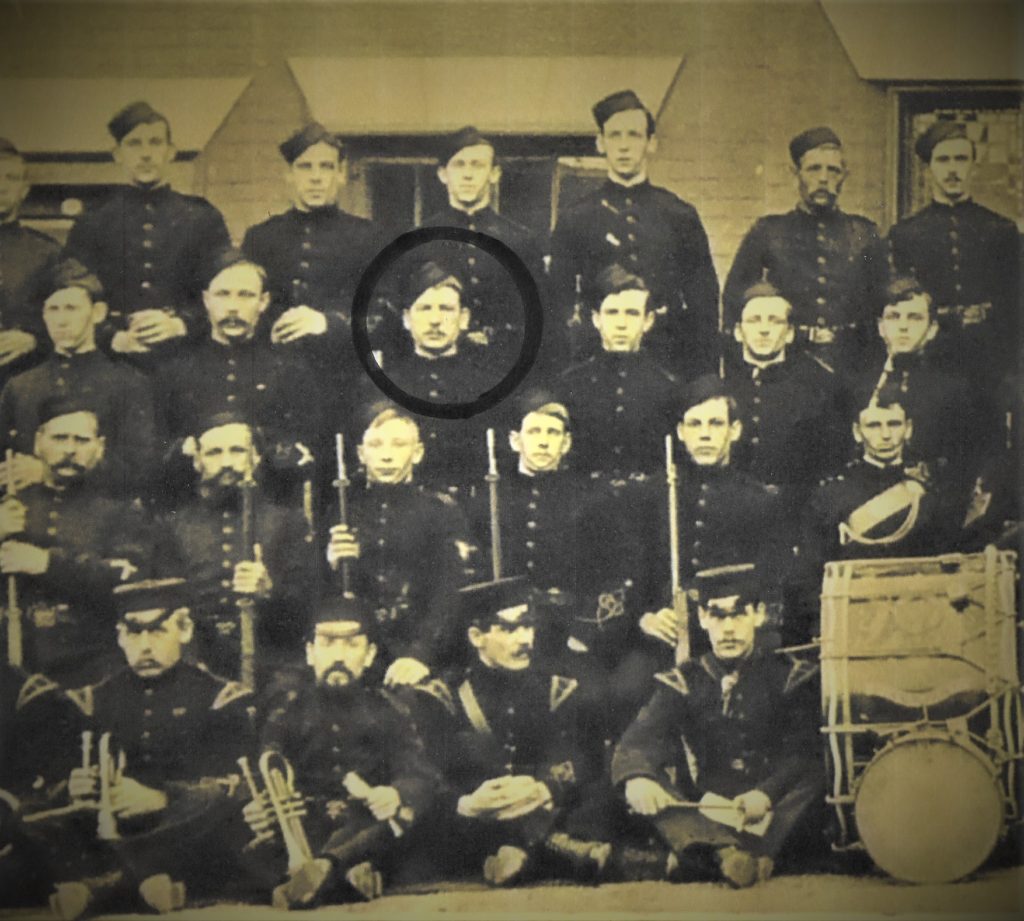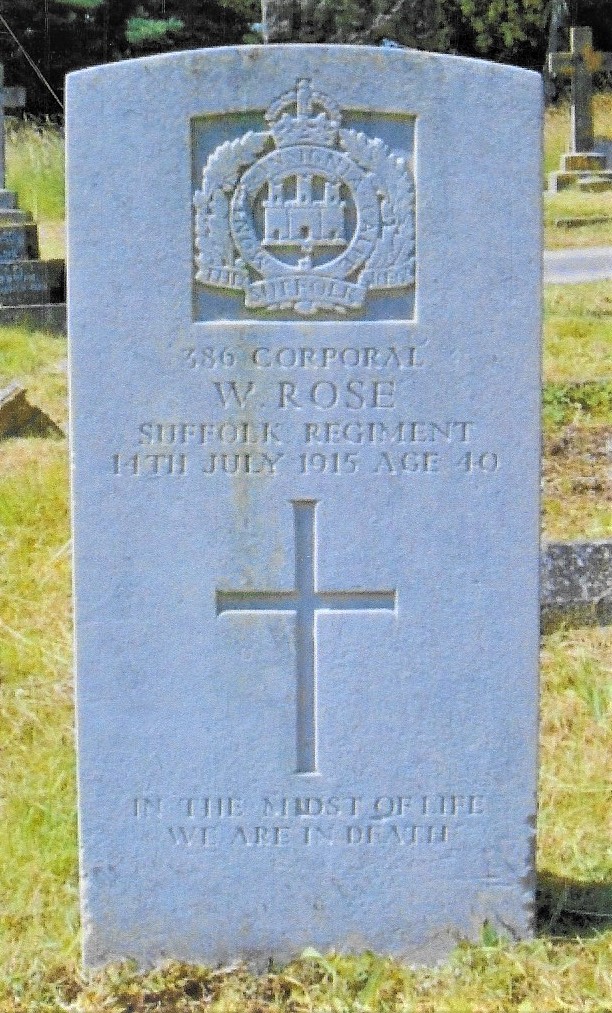386 CORPORAL WILLIAM ROSE
2ND/4TH BATTALION SUFFOLK REGIMENT T.F.
ATTACHED TO
64TH PROVISIONAL BATTALION
DIED OF HEART ATTACK
14TH JULY 1915
AGE 40 YEARS
William Rose had been, from the age of eighteen, a very keen member of the local military reserve forces. He had first enlisted into the Suffolk Artillery Militia. Shortly after completing his six year engagement, he had joined the Halesworth Company of the part-time 1st (Volunteer) Battalion, Suffolk Regiment with whom he remained until 1908 when they were replaced by the new Territorial Force (later army), transferring his service to them and serving right up until his death in 1915.
William Rose was born in Halesworth during the second quarter of 1875. He was the first son of Samuel, a brewery maltster, and Tamara (née Gilbert) born while they were living in Chediston Street. In 1880 he began his education at the town’s boys’ school where he later became known as a talented goalkeeper in the school’s football team, a sport he would continue to play after his school days, playing for several seasons in the town’s senior team. On leaving school he eventually found work as a fisherman, employed by a local businessman Mr J Gooch. On 4th March 1895 William’s military service began when he enlisted at Halesworth to join the Militia. This force had come back into being under the Government Act of 1852, which had reformed a branch of the army that had fallen into disuse after the Napoleonic Wars ended in 1815. Militiamen were expected to enter into full time training for a minimum period of fifty-six days before returning to their civilian life. Thereafter they had to report for further training for between twenty-one to twenty-eight days each year for the duration of their service, while being paid at Regular Army rates of pay when on duty. William joined the Suffolk Artillery Militia which, on its formation, had taken over the responsibility of manning the Coastal Artillery Batteries around the Suffolk coast from the Gunners of the regular army Royal Artillery. On enlistment he had become a Gunner with the regimental number of 1442. Having joined a technical branch of the Militia, his basic training lasted for a full seventy days. Over the following years he carried out a minimum of twenty-five days of full-time training every year. On 3rd March 1899 his six-year commitment expired with William having risen to the rank of Bombardier (Corporal). Within a short time of being discharged from the Militia, William joined the 1st Volunteer Battalion, Suffolk Regiment at their headquarters in the Rifle Hall, Halesworth where he remained until the demise of the Volunteers in 1908. During their final year, he became the proud winner of the Johnston Cup for the best all-round Volunteer of the previous year. On 1st April 1908, along with many of his friends, he transferred his service to the new Territorial Force to become 386, a Corporal in ‘F’ Company, 4th Battalion, Suffolk Regiment Territorial Force. Over all his years of service, when not on duty, he had carried out a normal civilian life. During the third quarter of 1898, while still serving in the Militia, William married Florence Alice Payne who hailed from Beccles. At this time he would have been found employed as a maltster, working at the Halesworth branch of the Colchester Brewing Co. Ltd at their premises in the Market Place. By the time of the 1911 census William and Florence were living with their five daughters and one son at 39 Chediston Street, with his occupation now listed as a maltster/wine with Florence shown as being a spirit merchant.
At the outbreak of World War One on 4th August 1914, William, with the rest of the Territorial Force, was mobilised. The following day the members of ‘F’ company left Halesworth to travel by train to their Battalion Headquarters in Ipswich. As they marched to the railway station, they were cheered all of the way by the residents of the town. Little could anyone have known at that time how many of these men and boys would never return. After gathering at Ipswich the next day, the 4th Suffolks were transported to their war station at Felixstowe to prepare for war. While there, plans were put in place to split the battalion into two separate formations. The men who had committed themselves to serve overseas after the introduction in 1910 of the Imperial Service Commitment or Pledge would now be known as the 1st/4th Battalion Suffolk Regiment T.F., while the remainder were now to be named the 2nd/4th Battalion. They would remain in England with the joint role of training new recruits while at the same time preparing anti-invasion defences. Now being forty years of age and having seven young children all under the age of thirteen and a wife to support, William had not signed the pledge, choosing to stay in England where due to his experience he would serve as a training Corporal. By July 1915, at the time of William’s death, he was based at Cromer on the North Norfolk coast where, although still manifested on the 2nd/4th Suffolks nominal roll, information shown on his Register of Soldier’s Effects card, he is listed as being attached to the 64th Provisional Battalion which had been formed just a month earlier, being made up of Home Service Territorials for the purpose of training new recruits. An article published in the Halesworth Times newspaper of 20th July 1915 reporting on William’s death and funeral, revealed that, on the afternoon of 14th July, he had just completed a period of guard duty and had decided to take a stroll along the Cromer sea front when he was seen to fall forward while appearing to suffer a fit. After receiving treatment at the scene, he was taken to Cromer Hospital. Back in Halesworth, at some time later, his wife Florence received a telegram regarding William. She had immediately set out to travel to Cromer, arriving at her husband’s bedside shortly before he passed away from a cerebral haemorrhage. The newspaper article then went on to report on William’s military funeral, held in Halesworth cemetery under the direction of Sergeant Major William Finch who had, prior to being mobilised, been the Regular Army instructor for the town’s Territorials. He had conducted the ceremony with due reverence, with six fellow Corporals acting as bearers, a bugler to play the Last Post, and with a firing party who fired a volley over William’s grave. As can be seen the Sergeant Major would also go on to lose his life in France during March 1918 (see his story).
After William’s death Florence applied for a widow’s pension for herself and her seven children which she was awarded on 25th January 1916 in the sum of £1.11s.6d (£1.38p) per week. This had been followed on 30th June 1919 by the second payment of a gratuity which totalled £7.11s.9d (£7.59p). She would also have been entitled to claim William’s named bronze memorial plaque and scroll. Having not seen any overseas service, she would not have been entitled to claim any war medals.
The location of the plaque and scroll is not known.

Circled: shows William on parade in the Market Place with members of the Halesworth Volunteer Training Corps, shortly after he had joined them in the early 1900’s. The Officer seated behind the drum is Major R.A. Parry D.S.O., who had later officiated at the unveiling of the town’s war memorial in March 1921.

